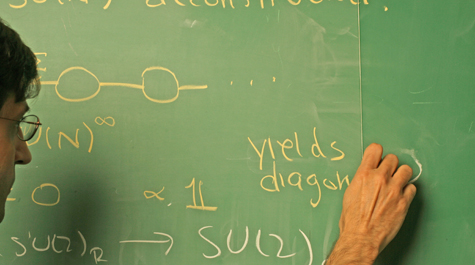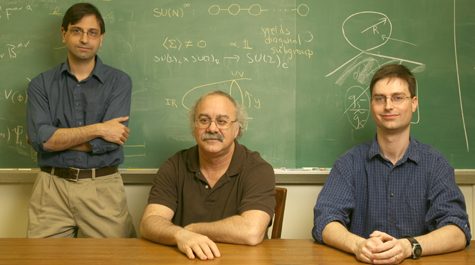Waiting for the hadrons to collide
As the Large Hadron Collider starts up in Europe, physicists worldwide are preparing for the immense volume of data to start coming in. Among the scientists prepared to analyze the data are members of William and Mary's High Energy Theory Group in Small Hall.
The Large Hadron Collider, or LHC, is the biggest and most expensive science experiment ever. It's housed underground in a 27-kilometer circular tunnel spanning the border of Switzerland and France, but involves scientists from around the world. The three physicists in the High Energy group—Chris Carone, Josh Erlich and Marc Sher—have collaborated on theoretical aspects of what the Large Hadron Collider might or might not find. As the raw data begin to pour from the LHC's detectors, the physicists will start to interpret the findings.
The central questions being investigated at the LHC have to do with the origins of mass. In the most basic of layman's terms, the LHC will examine the relationships between energy and mass—a quality essential in the makeup of physical objects. All of the things in our daily existence have mass, but at the sub-atomic level being probed inside the LHC, not all particles have mass.
About the Standard Model
The interactions of fundamental particles are described in a collection of theory and observed behavior called the Standard Model. A theoretical particle called the Higgs boson may explain how some of the fundamental particles get their mass—although there could be other explanations. It is the only particle predicted by the Standard Model that hasn't been observed. Discovery of the Higgs boson would initiate another set of questions.
"There are two different issues that often confuse lay people," Sher explained. "One is the Higgs itself. OK, that's a Standard Model prediction. A separate question is, why is it as light as it is?"
Erlich said that the experimental calculations indicate that the Higgs should be much, much heavier than the particle that the Standard Model calls for. To fit the Higgs into the Standard Model, "there are some miraculous possibilities that pop up," he said.
"If there are extra dimensions of space, that could help explain why the Higgs boson would be so light. If there is supersymmetry, which predicts all sorts of new particles that haven't been seen so far—some of which would be detected at the Large Hadron Collider—that could explain why the Higgs boson would be so light," Erlich said. "These possibilities are really grandiose and we might actually see evidence of extra dimensions if those ideas are correct. Those are the kind of things we like to think about."
What the physicists don't expect the LHC to find is nothing at all.
"The principles that underlie the successful theories that we have now tell us there must be something at the LHC. So when people ask the question, 'What if the LHC doesn't see anything?,' most of the time it's a misguided question," Carone said. "People have this idea it's like a box and you say well, if I open the box, I'll either find something or not find something. That's too simplistic a way to approach this. We have theories now that work and they're based on quantum mechanical principles that will go haywire if we don't see anything."
A veritable data firehose
Their role over the next few years will be to try to understand and interpret the torrents of data that will come from the LHC. Carone said the LHC experiments will provide a continual flow of fodder for physics theorists.
"The world wide web is a very good thing," Carone said. "Back when I was a graduate student, it used to be a slow process. There was a pre-print, then people would mail it to libraries, then two months later you'd get it and put it out on a stack and someone would read your pre-print. Now, it's instantaneous. We will be looking at the data that comes out and trying to make a connection with the range of theoretical ideas that we've been working with over the years."
With thousands of physicists across the globe tuned into the LHC data stream, the interpretive process may be wilder and woollier than many scientists have been used to. Any "bump" in the data may turn out to be the key to extra dimensions or a partial understanding of the Higgs boson, or any of the "miraculous possibilities" Erlich mentioned. Interpretation of raw data historically has been a more or less orderly procedure, characterized by a series of scientific papers which would be read, commented upon and refuted by members of the scientific community.
"It won't actually happen that way. The way it will happen is that there will be rumors. No papers yet, but there will be rumors from people who are collaborating," Sher predicted. "When you have a thousand people, there are going to be leaks. So there will be these rumors that in looking at the energies of pairs of muons coming out they see a bump that was not expected. There are always bumps, because it's statistical. Then the three of us will say 'Did you hear about that bump?' Then we'll all start to think about what could make that bump. By the time the bump is confirmed, there already will be dozens of papers on it. Most likely the bump goes away, so those dozens of papers become meaningless."
The one sure thing that the LHC will do is to change physics.
"It's interesting that within the next five years, 90 percent of all the papers that I’ve written in my career are going to be gone, dead, meaningless. But I just don’t know which 90 percent," Sher said. "That's fine. It’s expected. If you weren’t having your theories ruled out, you wouldn’t be doing a very good job."

















